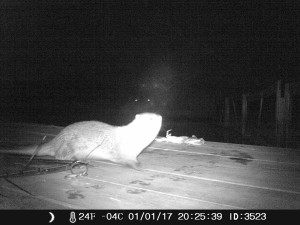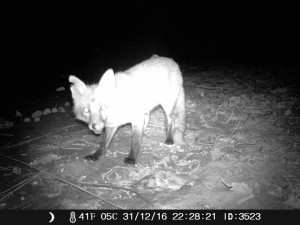Using a Trail Camera (Home and Classroom)

Wildlife Watching Unobtrusively
I find it a personal challenge to give gifts that will be meaningful and used well beyond the occasion when the gift was given. This Christmas I decided to buy a trail camera for my partner. In all fairness I thought it might be a good family gift too, mainly because I work in environmental education and I was also excited to see how one works and the potential use for educational programs or observations. What follows is a short article on my observations and suggestions for personal or educational uses of a trail camera (or multiple cameras).

What is a trail camera?
Trail cameras are also called game cameras because they are most often used to observe game animals and wildlife. There are many different shapes and styles of trail cameras depending on your budget and interest in using them, but alll trail cameras share some basic features. They are:
- Usually portable and small (can be lashed to trees)
- Rugged and waterproof so that that they can be outdoors
- Designed to operate independently of a person (motion activated)
- Possess a no-glow or infrared detection beam that detects movement
- Cameras that take still photos or video
- Conservative on battery power (replaceable or rechargeable)

Uses of trail cameras
Hunters have known about trail cameras for a long time, as have wildlife photographers and wildlife managers. However, with increasing resolution and photo quality, as well as decreasing cost, trail cameras have become quite popular for researchers, educators, and the general public. Here are some examples:
- A paper from Texas A&M researchers outlines potential research use of trail cameras, from observing turkey nests to predators, upland game birds, and hooved animals like deer and antelope.
- Researchers from Yale have used it for monitoring Sumatran tiger populations, and suggest ways of using it in inaccessible places, such as rain forest canopies, to study monkeys, reptiles, and forest dwelling organisms.
- Avian scientists have used trail cameras to evaluate nesting raptor (birds of prey) feeding patterns, focusing on the northern goshawk.
- Scientists from the University of Saskatchewan have used trail cameras to monitor turkey vulture breeding and nesting.

Of course there are many more uses such as:
- Tracking and recording the presence of nocturnal animals (sometimes pests)
- Seasonal population monitoring of deer (and trail monitoring)
- Turkey and game bird detection and monitoring
- Poacher detection and prevention
- Wolf and apex predator monitoring
- Endangered species home range tracking
- Nesting ecology of turtles and beach scavengers preying on turtle nests
- Security in and around homes
One major area of interest in trail cameras is classroom use. Trail cameras are exciting for students, because the images that they catch are always surprising and different. Here area a few ways to use the trail camera for the classroom:
- Habitat studies of local communities of animals
- Home range studies of animals
- Nocturnal animal studies
- Feeding habits and patterns of animals
- Food preference in animals
- Population studies of deer
- Human and animal use of habitat
- Video recording of animal behavior (from feeding to nesting)
- Comparison of temperature, time, and animal activity
There are many great resources for educators, but here are a few that you might want to look into first:
- Critter cam activity guide, from the USFWS Jeanu Field Office. This has great lessons on how to use the cams, and integrates lessons on graphing, mapping, and understanding habitats.
- "Taking Action Opportunities, connecting kids to wildlife with trail cameras." This is from the University of Minnesota and Minnesota Project Wild association. It has over 78 pages of activities, from setting up to using Google Earth. It also has pre-made data sheets and complete lesson plans.
- "Ten trail camera tips for family fun", National Wild Turkey Federation.
Using trail cameras in education, and at home, sounds great but what is the cost?

The trail camera the we bought from Amazon was the Crenova Game and Trail Hunting Camera 12MP 1080 HD with time lapse and infrared night vision. Around Christmas I purchased it for $85 but right now it's ranging from $92-$100. This is about average for a decent, every-day camera. The cost can be prohibitive for schools, nature centers, or individuals but the cameras are reusable and can last a long time, so they can be a good investment. If you have more than one camera you can obviously do more with specific trails, geographic areas, and habitats, but for every-day use we've been fine with one. For an education center I'd probably want at least four or five for maximum area coverage and to allow teams of students to work together (groups of 3-5 students).

How to get started with trail cameras
Obviously if you're just an average wildlife lover, or a hunter, your need for a robust trail camera will be different than that of a researcher. I'm not an expert who can give you advice, but here are a few resources that you might find handy:
Hunters, Teachers, and Wildlife Lovers:
- First time trail camera buyers guide, this page also has a quiz that will help you match your interests/budget with a camera.
- Big Game Logic, "What to look for when buying a trail camera."
- 2016 Best trail camera reviews and comparisons
Researchers and Upper Level Educators (also worth reading for those in the categories above):
- Ohio State University: "The basics of using remote cameras for monitoring wildlife."
- Wildlife Society Bulletin: "Identifying performance differences among trail cameras used to monitor forest mammals."
- PLOS One- "Evaluation of trail-cameras for analyzing the diet of nesting raptors using the Northern Goshawk as a Model."

A Few Tips and Tricks
I found that there are some tips and tricks to using a trail camera. The type of camera you use will define how you set it up and the type of exposure and images you get. With ours we found that it works best if it's set a ways off of the main site where you expect to see the animal(s), if it is too close then the ensuing "flash" (which is UV and animals can't see well) may over-expose the animal or reflect too much off it's fur (see picture below).

Heavily trafficked human areas are also usually heavily trafficked animal areas, particularly cut-throughs and places where humans may leave food or wrappers. Learn how to find animal (and human) trails and start tracking. Look for animal tracks in sand or mud and use those as cues that they might be good locations to set the camera.
Baiting is a subject of "de-bait" (love the puns). I don't see it as a problem if it is a one time activity for educational purposes and not hunting (which is illegal), especially for non-game animals. However, you must walk a fine line with what is and is not legal in your state. Be sure to read up on your state's rules and regulations. If in doubt, leave it out.

From my own experience I know that going out to retrieve your trail camera after a night of recording is exciting. it's the thrills of the unknown and of "What did I get this time?" It's like opening up a Cracker Jack box to see what is inside. I'm a boring adult, but for kids this can be even more exciting. I would highly recommend getting a trail camera as a birthday or family gift. It encourages you to get outside, interact with nature, and develop a greater understanding of what lives around you. I guarantee you that your local animal community is much larger than you think. It's also exciting to try to record specific animals. A trail camera is a great investment for your own use or the classroom.


